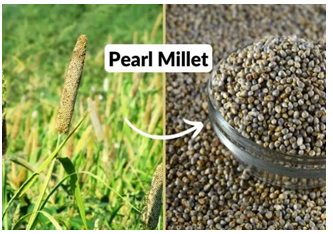

Context
According to a new study, India’s core pearl millet or Bajra production zone has shifted to 18 districts spread across eastern Rajasthan and Haryana between 1998 and 2017.
About
About the study:
- The study was conducted by the International Crops Research Institute for the Semi-arid Tropics (ICRISAT) and the Indian Council of Agricultural Research – All India Coordinated Research Project on Pearl Millet (ICAR-AICRP).
- It examined data from crop models and digital technology and suggested a revision of the Indian pearl millet Total Population Environments (TPE).
- It also suggested that an increase in rainfall triggered by human-induced climate change has led to the pearl millet zone shifting.
Pearl Millet and Zone Distribution in India:
- India classifies pearl millet cultivation zones based on rainfall patterns and soil types.
- Zones are classified as;
- The arid regions of Rajasthan, which receive less than 400 millimeters (mm) of rainfall, are categorized as Zone ‘A1’.
- Semi-arid regions in north and central India, including southern Rajasthan, Haryana, Gujarat, and Uttar Pradesh, which receive more than 400 mm of rainfall per year, form Zone ‘A’.
- Semi-arid regions with heavy soils in southern India and central western India with over 400 mm of rainfall from Zone B.
|
International Year of Millets: Food and Agriculture Organization (FAO) and United Nations haverecognized 2023 as International Year of Millets or IYM2023 for awareness about health and nutritional benefits of millets. |
Key Findings of the study:
- Sub-classifications: The paper revised ‘A’ into three subzones — ‘G’, ‘AE1’, and ‘AE2’.
- Zone ‘G’ covers Gujarat while AE1 covers eastern Rajasthan and Haryana.
- Zone ‘AE2’ covers 12 districts spread across Uttar Pradesh and Madhya Pradesh.
- ‘AE1’, which is now India’s core pearl millet production area with 39 percent production, saw an increase in production of 46 kilograms per hectare, owing to an increase in rainfall.
- The researchers noted that technological investments in irrigation, fertilization and new varieties that favored intensified cultivation practices also led to an increase in the zone’s pearl millet production.
- ‘AE2’ saw an average increase of 1,860 kg per hectare in bajra production between 1998 and 2017.
- Shifting trends: The paper also noted that climate change is contributing to more rainfall in Zone ‘G’ covering seven districts in Gujarat.
- This has led to farmers changing their cultivation patterns and switching from pearl millet to cash crops.
The Pearl Millet:
- The three major millets cultivated in India are Jowar, Bajra, and Ragi.
- Bajra is also known as the pearl millet.
- Scientific name: Pennisetumglaucum
- It is cultivated mainly in the semiarid tropics, almost exclusively by subsistence and small-scale commercial farmers.
- Optimal temperature requirement: Pearl millet grows best at temperatures between 27 to 32 degrees Celsius (81 to 90 degrees Fahrenheit).
- Temperature Tolerance: Pearl millet is known for its ability to withstand high temperatures, even exceeding 40 degrees Celsius (104 degrees Fahrenheit).
Significance:
- Pearl millet is gaining importance as a climate-resilient and health-promoting nutritious crop.
- Recent evidence using microsatellites suggests the monophyletic origin of pearl millet and its further migration and secondary diversification leading to enormous diversity.
|
A Scientific update:
|




